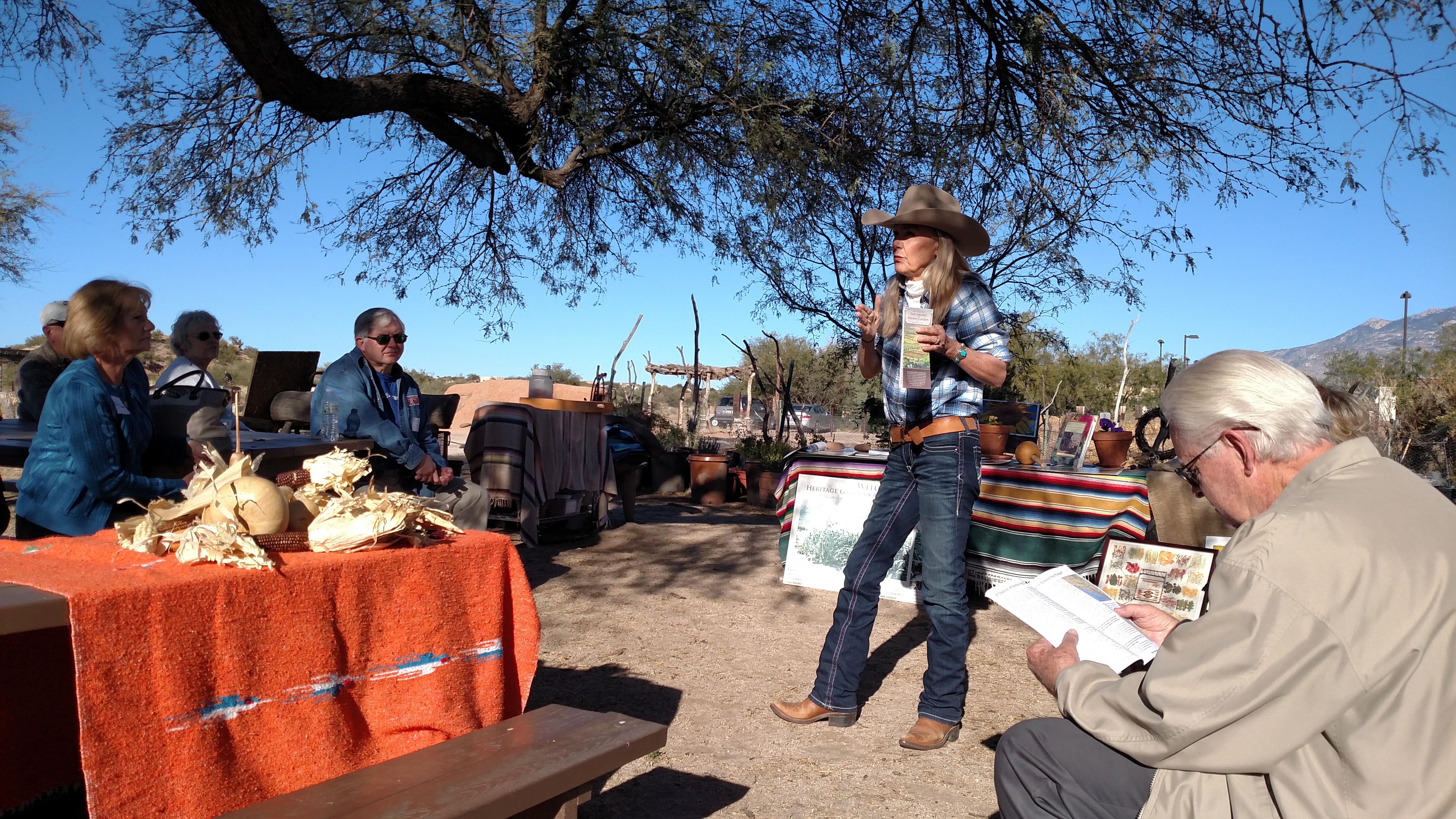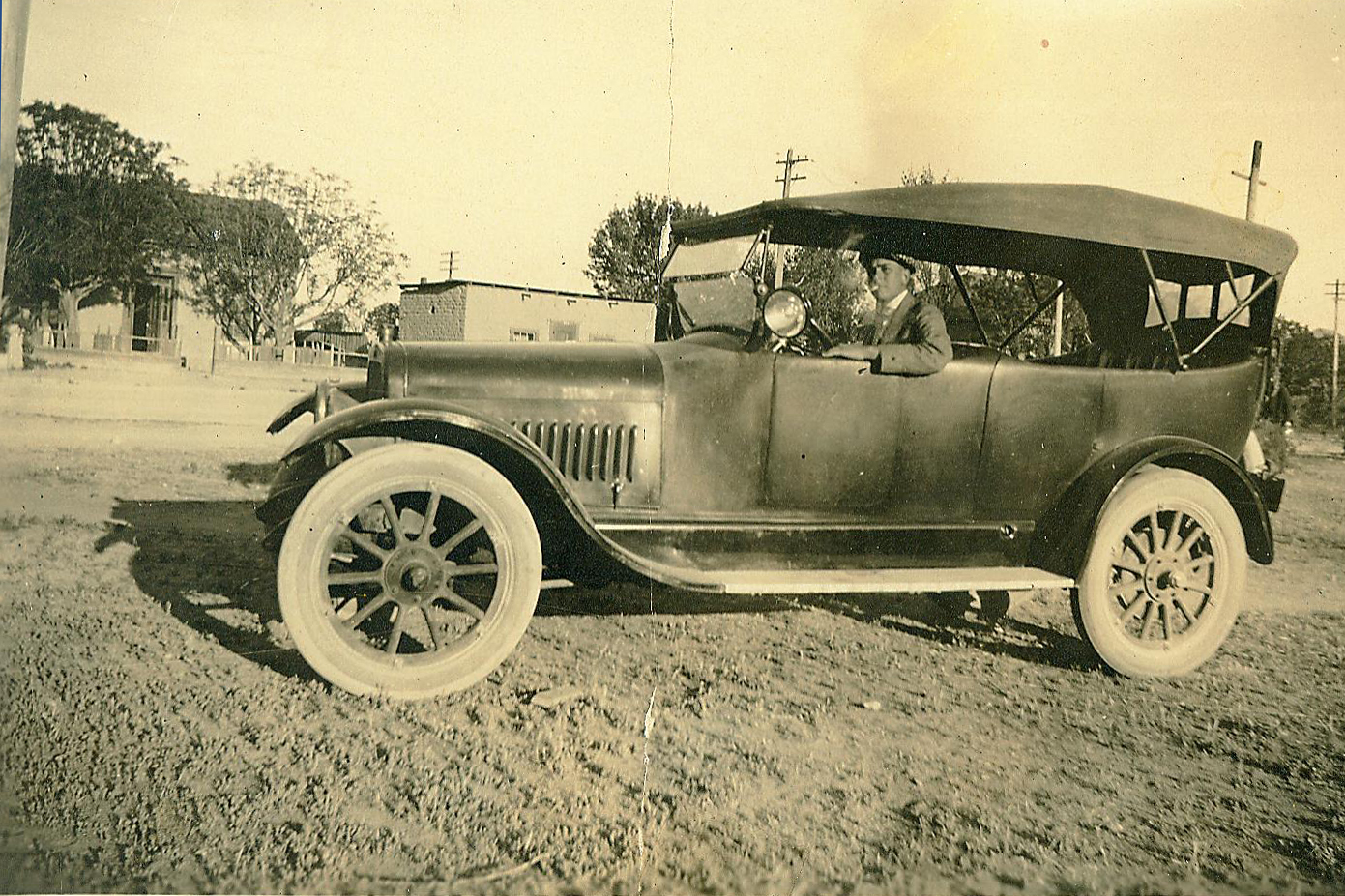Legend of image information at the bottom of the page
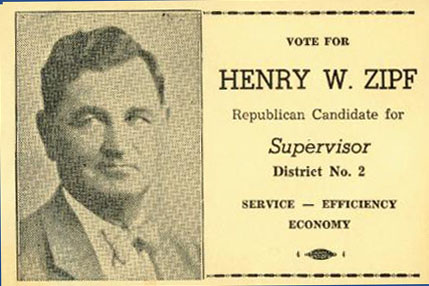
Henry Zif Collection
2006 Book 17
Henry Zipf Photo Collection
Date of Collection: 2006
Book # 17
Page #: 2006.17.01 – 2006.17.12
2006.17.01 (Oversized) Large group gathered outside in front of mountains
2006.17.02 (Oversized) Arizona Legislature
2006.17.03 Gertrude Pusch at age 12
2006.17.04 George Pusch Jr at age 10
2006.17.05 Henrietta Louise Pusch
2006.17.06 Wilhelmina Pusch
2006.17.07 Fritz Lewis Pusch
2006.17.08 Mathilda Feldman Pusch
2006.17.09 Gertrude Pusch
2006.17.10 George Pusch Jr.
2006.17.11 2 unidentified daughters of George and Mathilda Pusch
2006.17.12 3 unidentified children of George and Mathilda Pusch
Henry Zipf Photo Collection
Date of Collection: 2006
# in series:
Page #: 2006.15.01 — 2006.15.46
2006.15.01 Gertrude Pusch Zipf aka ‘Tootsie”
2006.15.02 Man and woman on steps of 4th Ave House
2006.15.03 Two woman, one is Mable Hawkins other unknown
2006.15.04 Right side of table is back of the head of Hank talking to unidentified male,
Gustav Kanabe, Wife Wilemina, then at the end of the table is an unidentified child and Louis Marie Ballinger, next to her is Robert Kanabe, Fred Pusch and Mabel Pusch Hawkins.
2006.15.05 Two woman and a man on Mt. Lemmon by Hank Soldier’s Camp area
2006.15.06 Steam Pump Ranch red building 1
2006.15.07 Steam Pump Ranch red building 2
2006.15.08 two gentleman sitting on a Mt. Lemmon ranger tower
2006.15.09 From the right, Jim Hawkins, Mabel Hawkins, possibly holding the
Armstrong twins, Nancy and Barbara, then Hank Zipf.
2006.15.10 Grand Canyon Picture postcard addressed to Frank Zipf from Viola
2006.15.11 Unidentifed man on horse
2006.15.12 Six gentlemen in suits gathered outside
2006.15.13 Armstrong girls, Nancy, Janet and Barbara
2006.15.14 No id but could be Elsa, Paul and family
2006.15.15 Gertrude and friends on Mt. Lemmon for the summer
2006.15.16 Young people on Mt. Lemmon
2006.15.17 Frank (Hardc’s brother), Robert Kanabe and Hank at Grandmother’s house at
428 S. 4th Ave in Tucson.
2006.15.18 two men and two women in school uniforms under tree
2006.15.19 family posed on rocks
2006.15.20 two couples in society dress
2006.15.21 couple in buggy with man standing at side
2006.15.22 a couple with another woman in buggy
2006.15.23 men and women under a tree
2006.15.24 Gertrude (2nd from the right) and friends
2006.15.25 Mabel Pusch Hawkins
2006.15.26 Picture postcard labeled “a street in Old Town”
2006.15.27 Mayor Engle presenting plaque for years of service on council to Vice
Mayor Henry Zipf.
2006.15.28 Hank on the left and Frank with dog, Ben at the Feldman Ranch
2006.15.29 Henry, Frank and friends
2006.15.30 Walter Feldman Pusch III
2006.15.31 Baby Walter on pony
2006.15.32 Louis Marie and Unknown
2006.15.33 Uncle Walter (George and Mathilda’s son) with child
2006.15.34 Henry and Frank
2006.15.35 Hank and Frank
2006.15.36 Hank and Frank in sailor outfits saluting with unknown girl
2006.15.37 Hank and Frank in sailor suits in front of house at N. Stone Ave.
2006.15.38 Frank, Henry and cousins
2006.15.39 Henry in cap and gown for high school graduation
2006.15.40 Walter Zipfs half brother and wife, Helen
2006.15.41 Back of lady walking on sidewalk at 28 S. 4th Ave
2006.15.42 Gertrude and Mabel Pusch
2006.15.43 Gertrude Pusch
2006.15.44 Group gathered at Arizona State Capital
2006.15.45 August 21, 1936 – boy in shirt, pants and boots holding something, could be
Walter
2006.15.46 Boy on horse with Steam Pump Ranch bunkhouses in background
Henry Zipf Photo Collection
Book Unknown
Book 5
Pusch Collection
Pictures and Photos
Date of Acquisition: 2006
# in series: 5
Page #: 2006.2.2 Photo #1 – 2006.2.2 Photo #18
2006.2.2 PhOl Young George Pusch
2006.2.2 Ph02 Horse and Buggy: 3 riders (date and place unknown)
2006.2.2 Ph03 December 9,1910: Members of the Arizona Constitution Convention
2 pictures, the lower one has member’s names written on it.
2006.2.2 Ph04 1914: Steam Pump Ranch House about 90 years ago.
2006.2.2 Ph05 1929: Steam Pump Ranch Building
2006.2.2 Ph06 1986: Steam Pump Ranch Building
2006.2.2 Ph07 October 18, 2003: Steam Pump Building
2006.2.2 Ph08 October 18, 2003: Steam Pump Ranch House (back view)
2006.2.2 Ph09 October 18, 2003: Steam Pump Ranch House (front view)
2006.2.2 Ph10 April 10, 1994: Pusch-Zellweger Ranch
2006.2.2 Phl 1 2 pictures: one vote for Henry Zipf Republican candidate for Supervisor,
District Number 2 Pima County and card with three small photos, one is of George, one of either Gertrude or Nonie.
2006.2.2 Ph12 Early picture of house downtown Tucson, AZ where Puschs and Zipfs lived
Believed to be house at 428 S. 4th Ave.
2006.2.2 Ph13 Article from Arizona Daily Star “You are architects of your record, Star told
Law makers 100 years ago”
2006.2.2 Ph14 7 pictures of the Pusch-Zelhveger (Feldman) Ranch
2006.2.2 Ph15 Large photo with the faces of several children and you people. Made in
Tucson, AZ but no additional information provided
2006.2.2 Ph16 19 miscellaneous post cards addressed to Zipfs.
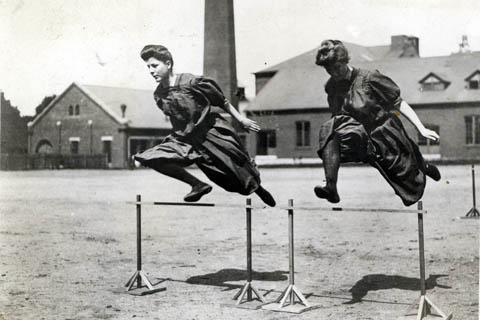
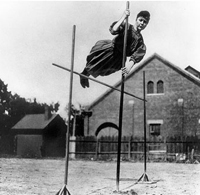
Ina Gittings, University of Nebraska in 1906, is shown in the earliest photograph of a woman vaulting.
INA GITTINGS
Ina Gittings
Pioneer Educator and Homesteader
By
Jim Williams
She was an early women’s educator, a community activist and a homesteader in Oro Valley. A major local roadway is named after her. Out how do you pronounce her name? Ina Gittings. You say EE-riah and I say EYE-nah? More on that later.
Ina sittings was born in 1885 in little Wilbur, Nebraska. Ina was a professional woman ahead of her time. She earned a university degree and led a successful, independent life. She never married.
Gittings graduated from the University of Nebraska in 1906. Her first job was OS a public school teacher in Lead, South Dakota. Ina served as a physical education instructor at the University of Nebraska from 1906-1909 and then spent six years as the director of women’s physical education at the University of Montana. She was a trailblazer in women’s athletics!
When America entered World War I in 1917, Ina Gittings left education and volunteered to go to France and serve as a physiotherapist, She helped the wounded young men to recover, After the war, she also served in relief efforts in Turkey.
-Miss Gittings came to teach and serve as Director of Women’s Physical Education at the University of Arizona in 1920. She completed a Master’s degree there in 1925 and continued to work at the University until 1955. She introduced female students to archery, track and field, horseback riding and other sports. Womenrs involvement in athletics was a new idea in the early twentieth century. Prior to that time.. girls were thought to be too frail for sports,
Before the 1970s, universities provided very little in funds or facilities for women’s athletics_ Men’s sports received the vast majority of athletic funds. ‘We struggled to get everything they [the girls] wanted to keep them interested. It was quite a battle sometimes, but we succeeded,” she later remembered. At one point, the women needed an extra athletic field for newly introduced sports. Only the Department of Agriculture’s onion fields were available. Ina won the battle and obtained the onion fields, but she and the female athletes first had to harvest the onions themselves.
Miss Gittings was very active in the Tucson community and in professional organizations. She served as the president of the National Women’s Overseas Service League of World war I. Ina was a member of the Tucson YWCA board and a charter member of the Alpha Phi sorority_ She often delivered talks on physical education and health to local organizations.
Ina Gittings was also one of Oro Valley’s early pioneers, She claimed two sections of federal land under the Homestead Acts in October, 1932. The sections totaled 480 acres. One parcel of 160 acres was located in what is now Rancho Vistoso, along Rancho Vistoso Boulevard and includes most of the Vistoso Vista subdivision. The other parcel, along what is now Ina Road, totaled 320 acres. This was located east of La Cholla Boulevard, between Magee Road and Ina Road. Homesteaders were required to build a residence to keep title to the land but did not have to live there full time. Miss Gittings had a home near the university and probably visited the homestead on weekends, as many Tucsonans did.
Ina Road was named for her Miss Gittings pronounced her name “E E-na h.” But our local Ina Road has come to be pronounced “EYE-nah.” She wrote letters to local newspapers complaining about people mispronouncing her road. Ina Road was unpaved when she homesteaded in Oro Valley in the early 193013s,
Professor Gittings stepped down from the position of Director of Women’s Physical Education in 1951. She kept her professorship and some teaching duties until fully retiring in 1S55. Richard Harvill, president of the University in the 196.0s, said “Miss Gittings served the University with complete dedication and competence for 35 years” and her influence on young women was well known and widely recognized.” She continued to deliver talks to community groups into the 1960s.
Ina Gittings died in 1966. The Gittings Memorial Fund was established in her honor. She is listed on the Women’s Plaza of Honor on the University of Arizona campus and Gittings Hall was s built in 1964 and named for her.When you drive on Ina Road, remember women’s educational pioneer and Oro Valley homesteader Ina (EE-nah) Gittings.
Published in OV Voice, May, 2014
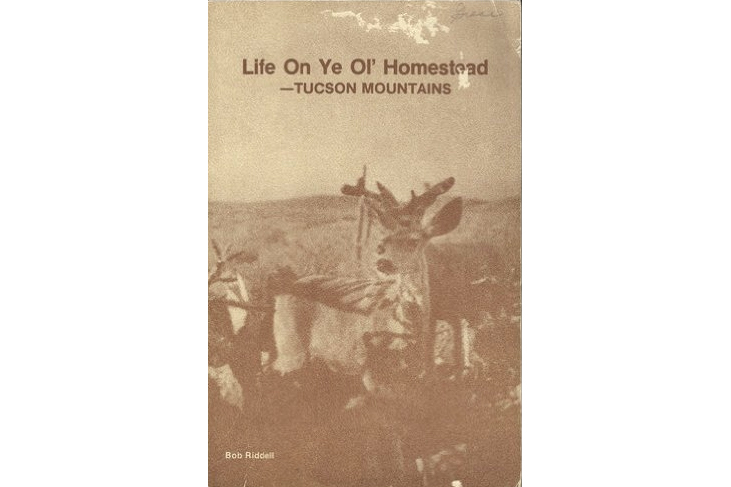
LIFE ON YE OL’ HOMESTEAD
— TUCSON MOUNTAINS
by
Bob Riddell
With Pertinent Notes as to Dates, Episodes, etc.
Provided by His Mother.
Hobnobbing With Royalty
In 1937, out of a clear blue sky, the folks decided it would be nice to have a “little nest egg” by renting the Homestead for six months or so and take a place in town. It came as a blow to Sis and I since we were so firmly planted in the life on the desert By this time we had graduated to a 1936 Dodge sedan, a bright maroon one, that was certainly a far cry from the “tank.”
An ad was readied for the local papers but, as luck would have it, one afternoon a large black sedan drove up the driveway. A chauffeur got out and opened the rear door. Out stepped a tall woman dressed in white including a white, wide brimmed hat She came to the front door accompanied by a tall, husky and good looking man.
Mom opened the door, and the visitor apologized for the trespassing and for the intrusion. She introduced herself as Lady Suffolk, and the gentleman as Colonel Gillette. They were both from England. They were invited in. A more charming and handsome woman I, nor the rest of the family, have never seen or met. She had been looking on the outskirts of Tucson, with the Colonel, for a home in private atmosphere for him. They preferred a period of six months for a minimum stay which could possibly last longer. The price was no object: that is within reason. Their search so far had been in vain for a place that suited his taste and hers.
After a tour of the Casa and a walk to the pump area guided by the folks, the two had a private conversation. They returned all smiles. Name a price, fully furnished, and the Colonel would like to take possession within two weeks. The Lady did all of the talking; was very business-like, yet spoke in such a manner it didn’t seem so.
There were three stipulations involved. First, no publicity or announcing to anyone about this venture. The Colonel wanted absolute privacy and would handle any intruders. It seems he had some sort of respiratory problem which required Tucson’s climate but out of the dust and pollen area. The second, was that Dad and I agree to come out once a week to turn on the pump. And the third, believe it or not, was that Jiggs remain. The Lady and the Colonel fell in love with him at once. And the darn cat purred as they stroked his back and whispered sweet nothings into his alerted ears. Could it be felines recognized royalty? We knew Sis would have a fit so Mom politely refused this request
We found a house near the U of A. and moved in, with a feeling that heaven was left behind. How does one act in civilization? Or react? For sure there was less mileage to contend with. Some consolation for me as the guns were left behind in my closet
There was a terrible time deciding how to tell friends of the move. “Well, let’s see.” Mom smiled. “our great aunt is occupied at the Casa writing a novel.”
“No. this sounds better,” I offered. “How about the place is haunted with ghosts of homebrewers?” Dirty looks came fast.
“We’ll have to think of something,” Sis said, which was true since the Colonel’s privacy must be protected.
“A big help, but no.” Dad replied, “we’ll just say the Homestead is rented and everyone please stay away.”
We had the privilege of calling at anytime. The first visit came a week after being in town. It was not a social visit. Sis was very upset because Jiggs was missing. All searched and called to no avail. The Colonel called from St. Mary’s and said it was urgent to come at once.
Upon arrival there was Jiggs in all of his glory sitting in his favorite chair on the front porch_ The Colonel smiled and pointed to the King of the Homestead. He had arrived the afternoon before footsore, tired and hungry. Sis was happy again. Mom heard cats have the built-in radar to perform this neat trick, but none gave it much thought. The Colonel suggested we take Jiggs back in a burlap sack placed on the floor of the car. We did One week later another phone call. Twice in a row? That’s what the man said.
It didn’t take long to find out why the darn feline traveled the hard way. It was his menu. No twenty-five cent hamburger. No, sir. Only the choicest of sirloin steak which the Colonel cut into small hunks. For a variation it was baked chicken also cut into tasty morsels. This was unbelievable. Just so Jiggs wouldn’t become bored, he was fed fancy canned meat imported from England. He even enjoyed dessert. Imported chocolate cookies which cost one dollar and one half per dozen.
There was no way we could keep Jiggs in town. There was an invitation to stay for dinner. My mouth waters at the thought of the dinner and dessert truly fit for royalty. But us?
Again it was quite noticeable how gracious Lady Suffolk could be. She had returned after a two weeks’ absence for a short stay before returning to England. We wondered if our manners were correct for dining with royalty, and do they use a knife and fork different from our style. Perhaps the Lady could read minds because she smiled when we gathered around the table and said to just be ourselves.
The Colonel was a great story teller and told of his experiences in the English Army and how he loved to prepare various food delights with the help of Arthur “There is nothing quite like a delicious meal,” he laughed, “and not just mutton, warm beer and Yorkshire Pudding.”
Lady Suffolk refrained from talking much about royalty except to give a brief history of her family heritage, which was really at the top of English bloodlines. She preferred to talk about business and predicted a great growth for Tucson and the surrounding area. She was a shrewd student of finance and made a painstaking study of the locale.
“I do not see how Tucson cannot grow forward in the future,” she said in a firm voice with an English accent. “All of the ingredients are here, like climate, beauty. The only thing is when.”
Years later, of course, her predictions came true The Colonel felt much better after his stay on the Homestead and begged the Lady to buy some land and build a home. He had fallen completely overboard with the desert. She refused and finally purchased a vast amount of land in what is now known as Suffolk Hills, located on the western slopes of the Santa Catalina Mountains.
The Colonel and Arthur drove out to the Casa on more than one occasion, and stayed as long as he could, even though the food certainly was a come down for his taste buds. He was very disturbed because he didn’t feel nearly as good since living in the other location.
And what a time we had getting Jiggs “down to earth after returning to the Casa. He refused to eat for two days, and then he reluctantly went back to hamburger. We will never forget the experience nor Lady Suffolk and the Colonel. Our friends never did know until long after who lived in the Homestead for six months.
